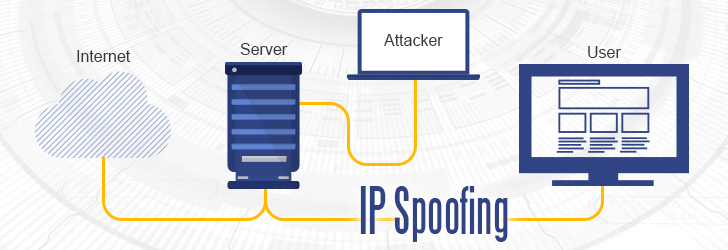
IP Spoofing is a technique used to gain unauthorized access to machines, whereby an attacker illicitly impersonates another machine by manipulating IP packets. IP Spoofing involves modifying the packet header with a forged (spoofed) source IP address, a checksum, and the order value. Internet is a packet switched network, which causes the packets leaving one machine may be arriving at the destination machine in different order. The receiving machine resembles the message based on the order value embedded in the IP header. IP spoofing involves solving the algorithm that is used to select the order sent values, and to modify them correctly.
This process usually starts by identifying your host and finding the IP address trusted by your host so that you can send data packets and the host will see them as originating from a trusted IP address but that’s not the case.
Hackers use IP spoofing to perform activities that are malicious and illegal. Some of the activities that can be performed include Service denial and man in the middle attacks. These two malicious acts are used by hackers to cause drama or havoc over the internet while hiding their identity.
Let's look at possible attacks that can be launched with the help of IP spoofing.
Man in the Middle
Just as the name suggests, this attack occurs when hackers interested in some information intercept data packets sent from one host to the next. Hackers do this man in the middle attack by accessing information sent from one end then alter it before releasing the information to the intended recipient. That means the recipient will receive altered information that is totally different from what was sent.
Man in the middle attack is mostly performed by individuals or organizations that are interested in knowing the information shared between the sender and the recipient.
Blinding
This form of attack occurs when a cracker or hacker sends an altered sequence of data packets to his target while not sure how data transmission within a network takes place.
It's a blind type of spoofing because the hacker is not sure about the sequence used in data transmission within a network they are interested in altering the data sent over it.
While hiding his identity, the hacker then takes advantage of the fact that he has accessed the data then injects wrong information into the packets of data without identifying himself or publicizing his identity. The recipient will receive altered data and believe that its data sent from the genuine sender without knowing that the data contains false information injected by a hacker.
Non-blinding
In this form of attack, the hacker resides in the same network as the target making it easy for him to notice or access transmissions. This, as a result, makes it easy for the hacker to tell or understand data sequence.
After getting access to the data sequence, the cracker can disguise himself and end up hijacking processes that have been established.
Service denial
This is a form of a storm that hackers use to attack a system while hiding their identity making it difficult to know the source of an attack.
This attack is usually done on a large scale denying several systems ability to access services over a network.
Spoofing is seen by many people as a negative thing but it can be a used in a positive application in some cases. One of these instances is Satellite internet accessibility. Providers of satellite services may sometimes rely on spoofing to avoid delays of information exchange.
However, for illegal spoofing there's always a way to control and stop it.
So you want to stop spoofing once and for all? Here are the main techniques you can always count on to prevent IP spoofing.
- Change authentication procedure: IP spoofing can be prevented by ensuring that there is encryption between hosts or machines that exchange data. Introduce exchange of keys between two systems that will be exchanging information so as to reduce the risk of IP spoofing.
- Introduce Filtering- This filtering should be introduced in a system that plans to prevent IP spoofing especially on outbound and inbound data traffic.
- Switches and router configuration: If your routers allow configuration you should reset them to reject strange data packets that may originate from a source different from the network.
- Deny Private addresses: Configure your system or network to ignore or disallow private IP addresses originating from outside.
- Allow encryption sessions: This should be set in such a way that only authenticated and trusted networks can access and interact with your network. Your router should be set to only allow trusted sources.
These are the surefire strategies used to stop IP spoofing once and for all. Now that you know, why not configure your router or system to avoid crackers from spoofing your IP?
Share this post
Leave a comment
All comments are moderated. Spammy and bot submitted comments are deleted. Please submit the comments that are helpful to others, and we'll approve your comments. A comment that includes outbound link will only be approved if the content is relevant to the topic, and has some value to our readers.

Comments (0)
No comment